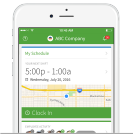How to Use Time and Attendance Software to Grow Your Business
Try When I Work for free
Buddy punching. Illegible ink. Spreadsheets. Calculators. Aspirin.
These are just a few of the joys of old school time and attendance tracking (if you’re even doing that much).
It’s tough to make a change in how you track employee time and attendance, but trust us, time and attendance software does a better job of tracking with more flexibility and significantly fewer headaches.
Build the work schedule in minutes, communicate with employees, and handle schedule changes with ease with When I Work.

Here are some of the things you need to know about time and attendance software:
- The software is usually hosted in the cloud, making it accessible to different employees and managers based on permissions. Being in the cloud also makes it more feasible for smaller businesses who don’t have the time or money to maintain software on their own systems.
- The software can generate automatic reports based on all of the incoming data that you and employees provide it. It isn’t “dead” data, locked in folders, binders, or old computer systems.
- Some software will show you where employees are working and for how long based on specific tasks.
- Some software has built in approval options so that managers can approve shifts, projects, or time requests.
- Some will integrate with a card swipe system (or even biometric) for improved data gathering.
As with any software choice, the best option for your business is based completely on your needs and employee numbers. Before you get around to choosing software, consider why time and attendance software will help you grow your business.
Understand why tracking time and attendance matters.
Maybe you think you have some leeway regarding absenteeism built into your policies, and that attendance and time tracking isn’t that important because everything will balance out in the long run.
Nope.
Quite simply, your business can’t grow if it’s losing money.
38% of employees have called in sick to work despite feeling perfectly well. What does that cost employers? According to Forbes, it costs businesses about $3,600 per year for hourly workers (and $2,650 for salaried workers) due to absenteeism.
Employees who are gone cost you money. Tracking time does a few things:
- You make sure employees are only being paid for the work they are actually doing. This is particularly important for hourly employees.
- You make sure salaried employees do more than meet their minimum “quota.”
- You make sure clients are paying for the time employees are devoting to them.
- You notice patterns of employees who abuse time-off policies (e.g. magically sick every sunny Friday).
Using software to track attendance and time improves your savings even more, which we’ll cover in a bit.
Build the work schedule in minutes, communicate with employees, and handle schedule changes with ease with When I Work.

Know when it’s time to automate.
That time-tracking spreadsheet might seem like automation, but it only works as well as the employee remembering to write down their actual time instead of making a guess.
If your business is small, relying on a manual approach to attendance and time tracking probably works. It’ll keep “probably working” until all of a sudden it’s at its breaking point and unraveling.
If you’re still using paper punch cards, static word processing documents, even computer-specific spreadsheets, or even older swipe card systems, you’re leaving the door open for system errors, illegible cards, or dishonesty (e.g. “buddy punching”, where employees punch in friends who are absent or running late), not to mention basic human error. It’s also likely that you’re tracking the bare minimum since that is all you can handle with an older system.
Good software takes the guesswork out of time and attendance calculation, and it also removes opportunities for dishonesty. If you’re overwhelmed by managing your current time and attendance system or realize there are discrepancies in employee time, choosing a time and attendance software should be your next step.
Spend your time on what matters.
Don’t ever forget that time is money.
In some large companies, when large numbers of employees clock in and out at the same time, they actually waste time waiting to punch in and out. Think about that. You are literally paying them, as they wait to punch in, to wait to punch out.
There are other big time wasters that come from an old-school approach to time and attendance tracking. For example, recording the time of an employee’s work is the most time-consuming aspect, but guess what’s second?
Calculating payroll.
Again, you’re literally spending time/money to calculate how to spend money for time.
One company, after switching from a manual time and attendance system to an automated approach, cut the time needed to deal with payroll from four days to one!
As a manager or owner, your time is valuable. It seems almost comical that so much of your time is used up calculating other’s time. The right software can put an end to this.
Get in procedural and legal compliance.
Relying on multiple manual approaches to track time and attendance opens the door for issues regarding overtime, he-said-she-said discrepancies, and conflicts with your internal policies. The more policies, employees, and laws you have to comply with, the more difficult it is to do everything by hand or by using two disparate systems that don’t integrate with each other.
By using time and attendance software, you can remove some of the wiggle room for error, and also easily see if employees are not adhering to company policies.
Find out how the day is spent.
Ever wonder where the time goes? Or why, after what seems like an adequate amount of time, employees don’t finish a project?
Time tracking software can help you and your employees know where the time is going with greater accuracy. You can spot the waste and see what needs improvement. You can see how long certain tasks tend to take.
You might find out you need to hire or shift your employees.
Charge clients what they owe.
If you’re charging clients based on the time devoted to their projects, you definitely need time tracking software.
Clients don’t want to feel like they got ripped off. They want to see how long the project took and that they are being billed fairly. This protects you, too. You have a leg to stand on should a client accuse you of padding your billed time.
Time tracking software is not just for charging by the hour for that specific project, though. By tracking time accurately for all of your projects, you’ll be able to make better time/cost estimates for future clients or service pricing. Time tracking builds a track record you can refer to.
Get smart about budgeting.
Time and attendance software should give you the ability to see projections of labor costs in the future. For example, if you have a peak season, you can export your data and use it to understand if over or understaffed during that time. Inversely, you can look at your slower times and determine if your staffing those most efficiently.
Set yourself up for growth.
With a staff of 5, you may be able to just get by calculating and creating schedules manually, but if you want to grow you need time attendance software. You need it to free up your time to focus on the growth of your business and you need it to scale once you do grow. Spend more of your time thinking about the future of your business rather than wasting hours in the minutia.
—
Time tracking and attendance software are about saving time and money, but also establishing a malleable data trove.
The first part is easy to understand when thinking in terms of growing your business, but it’s the second aspect–the ever-important data–that is often overlooked. The data that good software can gather is useful for future billing, budgeting, and planning.
When I Work has you covered when it comes to time and attendance software. Create your free employee scheduling account and we’ll throw in a free month.






